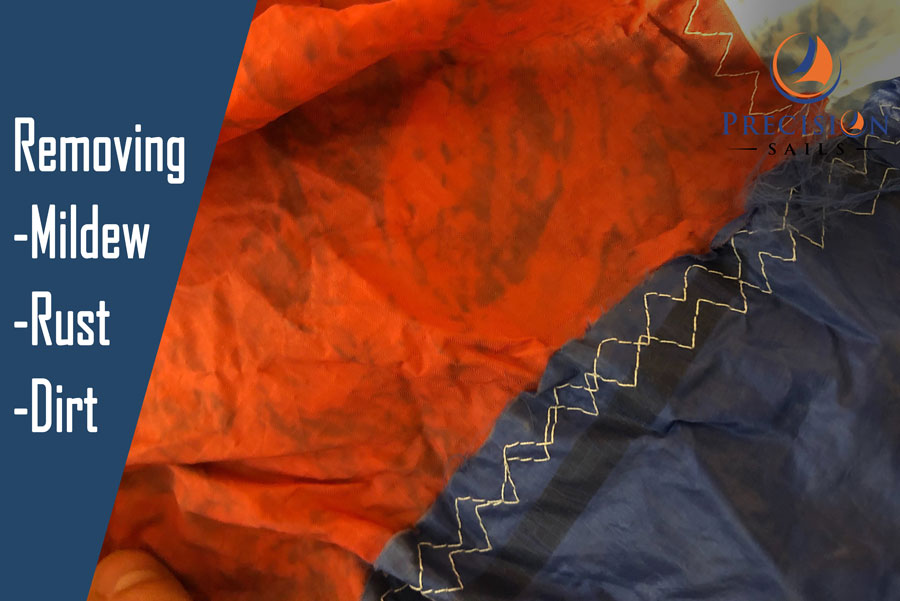
Why Do Sails Get Dirty?
Often, sails will be taken out of storage or unfurled, and the dreaded black blotches of mildew will rear their ugly head. There are two truths to this. First, mildew is a common occurrence on sails. And second, it is important to recognize that while unsightly and reducing the visual appeal of your sails there is no other effect as far as performance is concerned. Mildew is apparent on woven and laminate sails alike with a black blotchy appearance.
Mildew forms on sails when water is trapped between layers of material with little to no air flow. If you are sailing in tropical conditions are have stored your sail directly after wet weather has set in there is an increased risk of mildew forming. Similarly, the smooth surface of laminate sails makes an ideal home for mildew to form easier. Mildew can also form on the inside of laminate sails; this requires a more thorough cleaning procedure and is better left to professionals.
While chemical treatments are available and have been applied to many sails during production to reduce the forming of mildew, they are not very strong or often have worn away with time.
Rust stains can form on your sail from many different metal attachments or wires that are not stainless steel or properly protected to prevent rusting.
Cleaning your Sails
Regardless if you have noticed your sails becoming dirtier after pulling them out of storage or unfurling them this guide is aimed at helping reduce and remove mildew, rust and other markings on your sail.
Note: Rust and mildew stains may not be totally removed from your sail, but their appearance can be reduced by following these cleaning methods.
Cleaning Dirt
The best way to clean your sails is by hand with a clean sponge, a bucket of water and liquid soap. First, lay your sail out on a clean flat area. Once laid out fill your bucket with water and dilute some soap in it. Locate the areas that are the dirtiest (when spot-cleaning) and begin to lightly scrub with the wet sponge. If your sails are in good condition you may simply only need to spot clean rather than wash the entire sail. Once you have finished scrubbing the effected area rinse with clean water and let dry. Make sure the sail is completely dry before flaking and storing it.
Ideally wash you sail right before going cruising as it will dry thoroughly when fully exposed to the sun and wind. This will prevent mildew from growing on the sail when furled or inside its sail bag. Cleaning your sails is a good maintenance task to do annually or seasonally depending on your climate conditions.
Cleaning Mildew and Rust
For cleaning rust stains and marks try using acetone or rubbing alcohol. These chemicals are excellent at releasing deep dirt and stains from most cloth. They also both dry quickly which make them ideal for spot cleaning your sail before storing. While these cleaning agents will help to remove the rust there is often no way to fully reduce the red stain left behind. By washing the area with soap after using the chemicals you can reduce the red stain from red to a faded red. (This is why it is important to keep up on your sail maintenance and store them properly.)
For cleaning Mildew use a diluted bleach and water mixture. This will kill the mildew and release it from the fabric. Bleach can damage your sail over time so be sure to rinse thoroughly with clean water after cleaning. Similarly, mildew stains cloth and depending on the severity of the growth you may be left with a light grey stain. Chlorine free bleach is recommended as it is less acidic.
Mix one cup of non-chlorinated bleach with a small amount of soap per gallon of water. Spray your sail and let it soak in before scrubbing and finally rinsing off your sail.
Monitor the area and make sure to treat it any time it begins to grow darker. Mildew tends to regrow in the same location over time. Remove mildew from your sail as early as possible to avoid stains. You can also use Lysol wipes and spray to clean fresh mildew growth.
Oxyclean or white vinegar is another method to remove the mildew. Rinse well and dry after cleaning. Vinegar is a common household item used to battle mildew. However, on many accounts repeated cleaning with vinegar will be required to battle the growing mildew.
Avoid using BLEACH on Kevlar and Nylon. This means no spinnakers! For your safety Bleach and Ammonia should not be combined as this makes a poisonous gas.


